2013 NISSAN GT-R engine overheat
[x] Cancel search: engine overheatPage 18 of 346
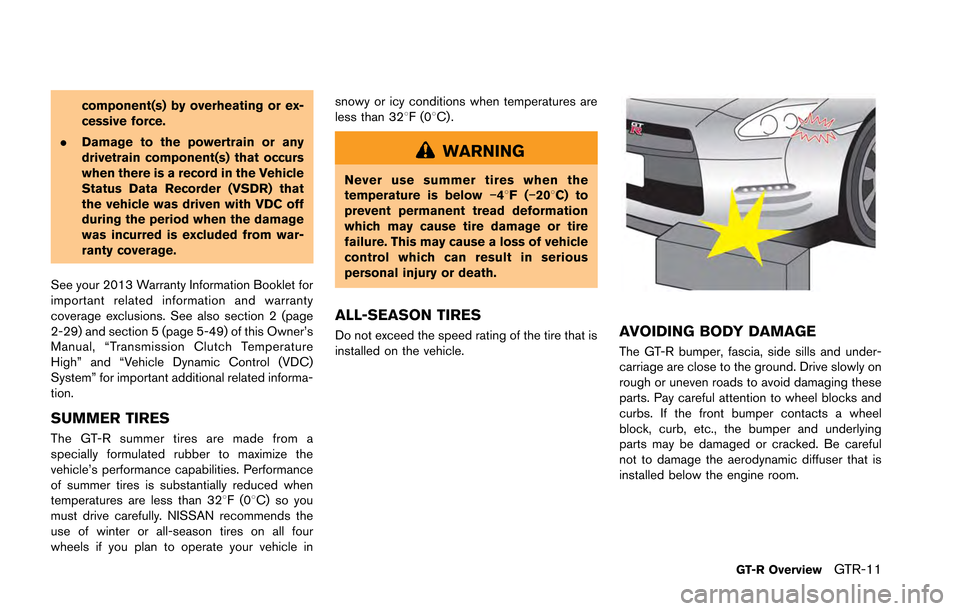
component(s) by overheating or ex-
cessive force.
. Damage to the powertrain or any
drivetrain component(s) that occurs
when there is a record in the Vehicle
Status Data Recorder (VSDR) that
the vehicle was driven with VDC off
during the period when the damage
was incurred is excluded from war-
ranty coverage.
See your 2013 Warranty Information Booklet for
important related information and warranty
coverage exclusions. See also section 2 (page
2-29) and section 5 (page 5-49) of this Owner’s
Manual, “Transmission Clutch Temperature
High” and “Vehicle Dynamic Control (VDC)
System” for important additional related informa-
tion.
SUMMER TIRES
The GT-R summer tires are made from a
specially formulated rubber to maximize the
vehicle’s performance capabilities. Performance
of summer tires is substantially reduced when
temperatures are less than 328F(0 8C) so you
must drive carefully. NISSAN recommends the
use of winter or all-season tires on all four
wheels if you plan to operate your vehicle in snowy or icy conditions when temperatures are
less than 328F(0
8C) .
WARNING
Never use summer tires when the
temperature is below −48F(−208C) to
prevent permanent tread deformation
which may cause tire damage or tire
failure. This may cause a loss of vehicle
control which can result in serious
personal injury or death.
ALL-SEASON TIRES
Do not exceed the speed rating of the tire that is
installed on the vehicle.AVOIDING BODY DAMAGE
The GT-R bumper, fascia, side sills and under-
carriage are close to the ground. Drive slowly on
rough or uneven roads to avoid damaging these
parts. Pay careful attention to wheel blocks and
curbs. If the front bumper contacts a wheel
block, curb, etc., the bumper and underlying
parts may be damaged or cracked. Be careful
not to damage the aerodynamic diffuser that is
installed below the engine room.
GT-R OverviewGTR-11
Page 20 of 346

PRECAUTIONS ON PERFORMANCE
DRIVING
The information and specifications in this
section apply only when engaging in
performance driving.
Checking the temperature of the
coolant and oils on the multi func-
tion display
When the temperatures of the engine coolant
and oil, and the oil pressure exceed the normal
range, the color of the meter on the multi
function display changes to red to warn the
driver. When engaging in high performance
driving, switch the display to the function meter
to display the temperature of the engine coolant
and oil, and the oil pressure. When the color of
the meter display changes to red, perform cool
down driving. When the values of the tempera-
ture and pressure return to the normal range, the
color of the meter display will turn back to white.
Warning temperature:
.Engine coolant temperature is 2308 F
(1108C) or higher:
If the engine coolant temperature increases
above 2308F (1108C) , the color of the meter
display on the multi function display changes
to red to warn of a possible overheat condition and engine output is reduced.
. Engine oil temperature is 2758F (1358C) or
higher:
If the engine oil temperature is higher than
2758F (1358C), the meter display changes
to red, maximum engine speed is automati-
cally limited to 4,000 rpm, and the transmis-
sion automatically changes from the
&Mposition to the&Aposition.
. Transmission oil temperature is 2848 F
(1408C) or higher:
If the transmission oil temperature increases
to over 2848F (1408C) , the color of the
meter display changes to red. However, the
vehicle can continue to be driven until the
temperature reaches 2958F (1468C) . If the
oil temperature exceeds 2848 F (1408C)
while driving (the color of the meter dis-
played in red) , change both the transmission
oil and the differential oil after driving
because these fluids have deteriorated
because of the heat.
Cool down
The information and specifications in this
section apply only when engaging in
performance driving.
Cool down the vehicle to help extend the life of the vehicle if coolant temperatures are extremely
high. Drive the vehicle at 37 to 50 MPH (60 to
80 km/h), in 5th or 6th gear for 2 to 3 miles (3 to
5 km) and then stop the engine.
Refueling precautions
WARNING
Do not attempt to top off the fuel tank
after the fuel pump nozzle shuts off
automatically. Continued refueling may
cause fuel overflow, resulting in fuel
spray and possibly a fire. The fuel tank
is full at the first automatic shutoff.
To maximize vehicle performance, the fuel tank is
located as low as possible to lower the vehicle
center of gravity. The tank is also divided into
two parts. This fuel tank design causes higher
pressures inside the tank than other vehicles so
fuel spillage is possible by trying to top off the
fuel tank after automatic shutoff.
The fuel tank pressure is higher when the vehicle
is hot, especially if the tank is more than half full.
If the cap is opened when the vehicle is hot, it
may cause fuel spray and there may be a hissing
noise. Open the cap slowly, releasing the
pressure from the tank gradually. Also, if the
GT-R OverviewGTR-13
Page 36 of 346
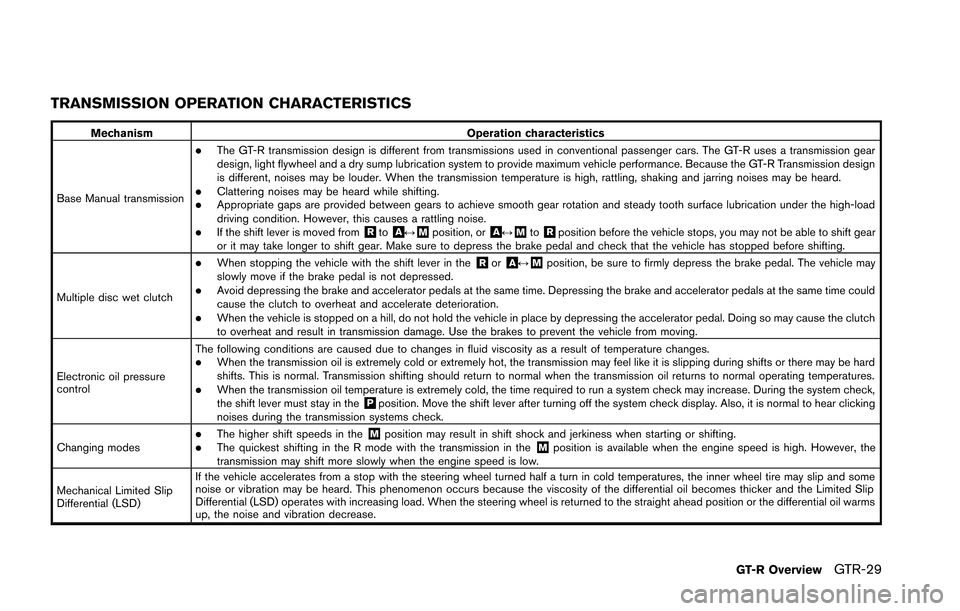
TRANSMISSION OPERATION CHARACTERISTICS
MechanismOperation characteristics
Base Manual transmission
.The GT-R transmission design is different from transmissions used in conventional passenger cars. The GT-R uses a transmission gear
design, light flywheel and a dry sump lubrication system to provide maximum vehicle performance. Because the GT-R Transmission design
is different, noises may be louder. When the transmission temperature is high, rattling, shaking and jarring noises may be heard.
.Clattering noises may be heard while shifting..Appropriate gaps are provided between gears to achieve smooth gear rotation and steady tooth surface lubrication under the high-load
driving condition. However, this causes a rattling noise.
.If the shift lever is moved from&Rto&A↔&Mposition, or&A↔&Mto&Rposition before the vehicle stops, you may not be able to shift gear
or it may take longer to shift gear. Make sure to depress the brake pedal and check that the vehicle has stopped before shifting.
Multiple disc wet clutch
.When stopping the vehicle with the shift lever in the&Ror&A↔&Mposition, be sure to firmly depress the brake pedal. The vehicle may
slowly move if the brake pedal is not depressed.
.Avoid depressing the brake and accelerator pedals at the same time. Depressing the brake and accelerator pedals at the same time could
cause the clutch to overheat and accelerate deterioration.
.When the vehicle is stopped on a hill, do not hold the vehicle in place by depressing the accelerator pedal. Doing so may cause the clutch
to overheat and result in transmission damage. Use the brakes to prevent the vehicle from moving.
Electronic oil pressure
control The following conditions are caused due to changes in fluid viscosity as a result of temperature changes.
.When the transmission oil is extremely cold or extremely hot, the transmission may feel like it is slipping during shifts or there may be hard
shifts. This is normal. Transmission shifting should return to normal when the transmission oil returns to normal operating temperatures.
.When the transmission oil temperature is extremely cold, the time required to run a system check may increase. During the system check,
the shift lever must stay in the&Pposition. Move the shift lever after turning off the system check display. Also, it is normal to hear clicking
noises during the transmission systems check.
Changing modes
.The higher shift speeds in the&Mposition may result in shift shock and jerkiness when starting or shifting..The quickest shifting in the R mode with the transmission in the&Mposition is available when the engine speed is high. However, the
transmission may shift more slowly when the engine speed is low.
Mechanical Limited Slip
Differential (LSD) If the vehicle accelerates from a stop with the steering wheel turned half a turn in cold temperatures, the inner wheel tire may slip and some
noise or vibration may be heard. This phenomenon occurs because the viscosity of the differential oil becomes thicker and the Limited Slip
Differential (LSD) operates with increasing load. When the steering wheel is returned to the straight ahead position or the differential oil warms
up, the noise and vibration decrease.
GT-R OverviewGTR-29
Page 102 of 346
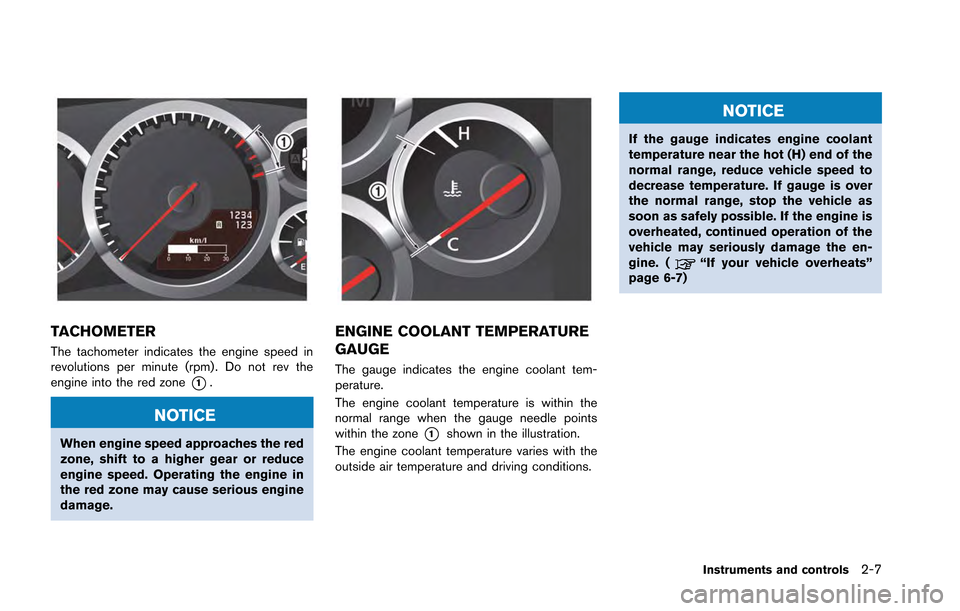
TACHOMETER
The tachometer indicates the engine speed in
revolutions per minute (rpm) . Do not rev the
engine into the red zone
*1.
NOTICE
When engine speed approaches the red
zone, shift to a higher gear or reduce
engine speed. Operating the engine in
the red zone may cause serious engine
damage.
ENGINE COOLANT TEMPERATURE
GAUGE
The gauge indicates the engine coolant tem-
perature.
The engine coolant temperature is within the
normal range when the gauge needle points
within the zone
*1shown in the illustration.
The engine coolant temperature varies with the
outside air temperature and driving conditions.
NOTICE
If the gauge indicates engine coolant
temperature near the hot (H) end of the
normal range, reduce vehicle speed to
decrease temperature. If gauge is over
the normal range, stop the vehicle as
soon as safely possible. If the engine is
overheated, continued operation of the
vehicle may seriously damage the en-
gine. (
“If your vehicle overheats”
page 6-7)
Instruments and controls2-7
Page 149 of 346
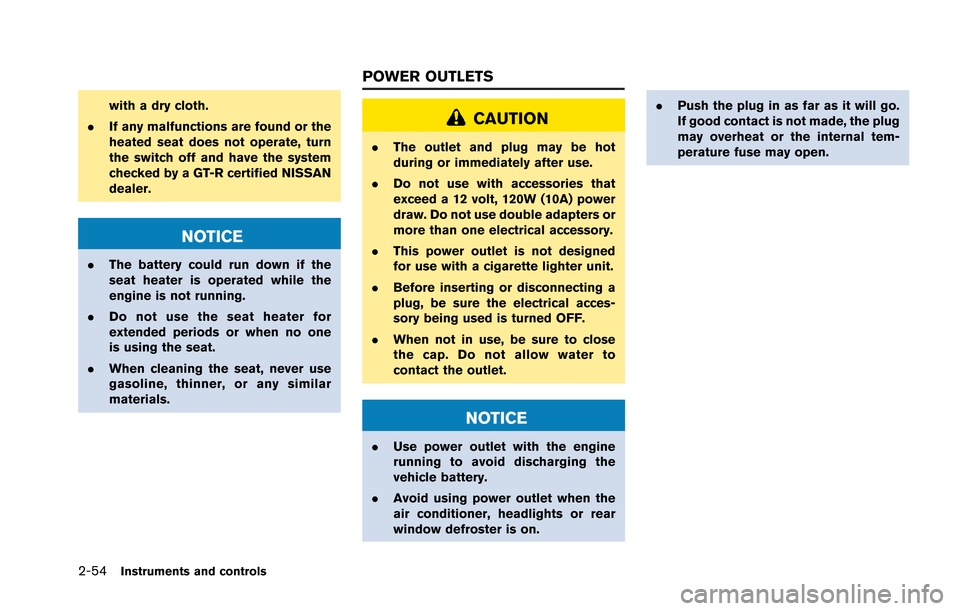
2-54Instruments and controls
with a dry cloth.
. If any malfunctions are found or the
heated seat does not operate, turn
the switch off and have the system
checked by a GT-R certified NISSAN
dealer.
NOTICE
.The battery could run down if the
seat heater is operated while the
engine is not running.
. Do not use the seat heater for
extended periods or when no one
is using the seat.
. When cleaning the seat, never use
gasoline, thinner, or any similar
materials.
CAUTION
.The outlet and plug may be hot
during or immediately after use.
. Do not use with accessories that
exceed a 12 volt, 120W (10A) power
draw. Do not use double adapters or
more than one electrical accessory.
. This power outlet is not designed
for use with a cigarette lighter unit.
. Before inserting or disconnecting a
plug, be sure the electrical acces-
sory being used is turned OFF.
. When not in use, be sure to close
the cap. Do not allow water to
contact the outlet.
NOTICE
.Use power outlet with the engine
running to avoid discharging the
vehicle battery.
. Avoid using power outlet when the
air conditioner, headlights or rear
window defroster is on. .
Push the plug in as far as it will go.
If good contact is not made, the plug
may overheat or the internal tem-
perature fuse may open.
POWER OUTLETS
Page 197 of 346
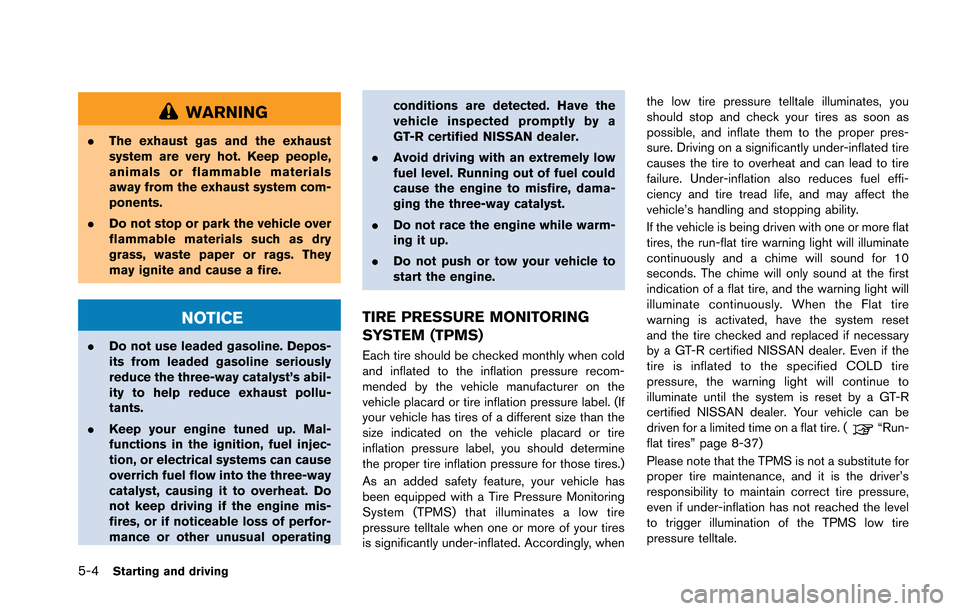
5-4Starting and driving
WARNING
.The exhaust gas and the exhaust
system are very hot. Keep people,
animals or flammable materials
away from the exhaust system com-
ponents.
. Do not stop or park the vehicle over
flammable materials such as dry
grass, waste paper or rags. They
may ignite and cause a fire.
NOTICE
.Do not use leaded gasoline. Depos-
its from leaded gasoline seriously
reduce the three-way catalyst’s abil-
ity to help reduce exhaust pollu-
tants.
. Keep your engine tuned up. Mal-
functions in the ignition, fuel injec-
tion, or electrical systems can cause
overrich fuel flow into the three-way
catalyst, causing it to overheat. Do
not keep driving if the engine mis-
fires, or if noticeable loss of perfor-
mance or other unusual operating conditions are detected. Have the
vehicle inspected promptly by a
GT-R certified NISSAN dealer.
. Avoid driving with an extremely low
fuel level. Running out of fuel could
cause the engine to misfire, dama-
ging the three-way catalyst.
. Do not race the engine while warm-
ing it up.
. Do not push or tow your vehicle to
start the engine.
TIRE PRESSURE MONITORING
SYSTEM (TPMS)
Each tire should be checked monthly when cold
and inflated to the inflation pressure recom-
mended by the vehicle manufacturer on the
vehicle placard or tire inflation pressure label. (If
your vehicle has tires of a different size than the
size indicated on the vehicle placard or tire
inflation pressure label, you should determine
the proper tire inflation pressure for those tires.)
As an added safety feature, your vehicle has
been equipped with a Tire Pressure Monitoring
System (TPMS) that illuminates a low tire
pressure telltale when one or more of your tires
is significantly under-inflated. Accordingly, when the low tire pressure telltale illuminates, you
should stop and check your tires as soon as
possible, and inflate them to the proper pres-
sure. Driving on a significantly under-inflated tire
causes the tire to overheat and can lead to tire
failure. Under-inflation also reduces fuel effi-
ciency and tire tread life, and may affect the
vehicle’s handling and stopping ability.
If the vehicle is being driven with one or more flat
tires, the run-flat tire warning light will illuminate
continuously and a chime will sound for 10
seconds. The chime will only sound at the first
indication of a flat tire, and the warning light will
illuminate continuously. When the Flat tire
warning is activated, have the system reset
and the tire checked and replaced if necessary
by a GT-R certified NISSAN dealer. Even if the
tire is inflated to the specified COLD tire
pressure, the warning light will continue to
illuminate until the system is reset by a GT-R
certified NISSAN dealer. Your vehicle can be
driven for a limited time on a flat tire. (
“Run-
flat tires” page 8-37)
Please note that the TPMS is not a substitute for
proper tire maintenance, and it is the driver’s
responsibility to maintain correct tire pressure,
even if under-inflation has not reached the level
to trigger illumination of the TPMS low tire
pressure telltale.
Page 209 of 346
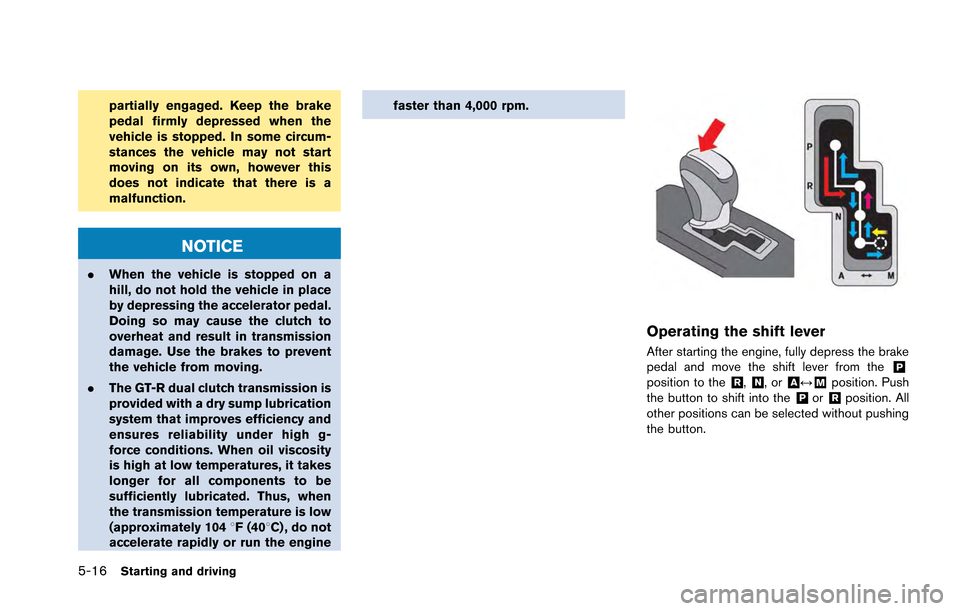
5-16Starting and driving
partially engaged. Keep the brake
pedal firmly depressed when the
vehicle is stopped. In some circum-
stances the vehicle may not start
moving on its own, however this
does not indicate that there is a
malfunction.
NOTICE
.When the vehicle is stopped on a
hill, do not hold the vehicle in place
by depressing the accelerator pedal.
Doing so may cause the clutch to
overheat and result in transmission
damage. Use the brakes to prevent
the vehicle from moving.
. The GT-R dual clutch transmission is
provided with a dry sump lubrication
system that improves efficiency and
ensures reliability under high g-
force conditions. When oil viscosity
is high at low temperatures, it takes
longer for all components to be
sufficiently lubricated. Thus, when
the transmission temperature is low
(approximately 104 8F (408C) , do not
accelerate rapidly or run the engine faster than 4,000 rpm.
Operating the shift lever
After starting the engine, fully depress the brake
pedal and move the shift lever from the&Pposition to the&R,&N,or&A↔&Mposition. Push
the button to shift into the&Por&Rposition. All
other positions can be selected without pushing
the button.
Page 214 of 346
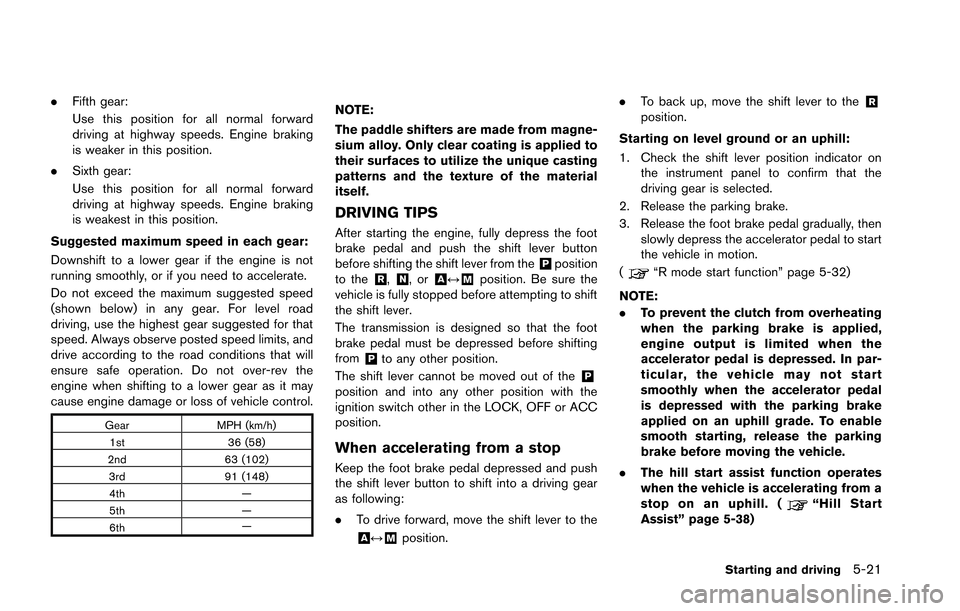
.Fifth gear:
Use this position for all normal forward
driving at highway speeds. Engine braking
is weaker in this position.
. Sixth gear:
Use this position for all normal forward
driving at highway speeds. Engine braking
is weakest in this position.
Suggested maximum speed in each gear:
Downshift to a lower gear if the engine is not
running smoothly, or if you need to accelerate.
Do not exceed the maximum suggested speed
(shown below) in any gear. For level road
driving, use the highest gear suggested for that
speed. Always observe posted speed limits, and
drive according to the road conditions that will
ensure safe operation. Do not over-rev the
engine when shifting to a lower gear as it may
cause engine damage or loss of vehicle control.
Gear MPH (km/h)
1st 36 (58)
2nd 63 (102)
3rd 91 (148)
4th —
5th —
6th —
NOTE:
The paddle shifters are made from magne-
sium alloy. Only clear coating is applied to
their surfaces to utilize the unique casting
patterns and the texture of the material
itself.
DRIVING TIPS
After starting the engine, fully depress the foot
brake pedal and push the shift lever button
before shifting the shift lever from the
&Pposition
to the&R,&N,or&A↔&Mposition. Be sure the
vehicle is fully stopped before attempting to shift
the shift lever.
The transmission is designed so that the foot
brake pedal must be depressed before shifting
from
&Pto any other position.
The shift lever cannot be moved out of the
&Pposition and into any other position with the
ignition switch other in the LOCK, OFF or ACC
position.
When accelerating from a stop
Keep the foot brake pedal depressed and push
the shift lever button to shift into a driving gear
as following:
. To drive forward, move the shift lever to the
&A↔&Mposition. .
To back up, move the shift lever to the
&Rposition.
Starting on level ground or an uphill:
1. Check the shift lever position indicator on the instrument panel to confirm that the
driving gear is selected.
2. Release the parking brake.
3. Release the foot brake pedal gradually, then slowly depress the accelerator pedal to start
the vehicle in motion.
(
“R mode start function” page 5-32)
NOTE:
. To prevent the clutch from overheating
when the parking brake is applied,
engine output is limited when the
accelerator pedal is depressed. In par-
ticular, the vehicle may not start
smoothly when the accelerator pedal
is depressed with the parking brake
applied on an uphill grade. To enable
smooth starting, release the parking
brake before moving the vehicle.
. The hill start assist function operates
when the vehicle is accelerating from a
stop on an uphill. (
“Hill Start
Assist” page 5-38)
Starting and driving5-21